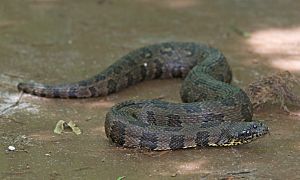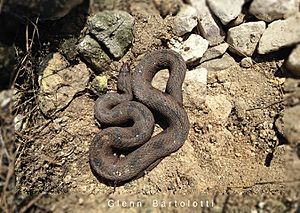Brown water snake facts for kids
Quick facts for kids Brown water snake |
|
|---|---|
 |
|
| Nerodia taxispilota in West Palm Beach, Florida | |
| Conservation status | |
| Scientific classification | |
| Genus: |
Nerodia
|
| Species: |
taxispilota
|
| Synonyms | |
|
|
The brown water snake (Nerodia taxispilota) is a large snake that is not venomous. It lives only in the southeastern United States. This snake is known for its unique patterns and its love for watery places.
Another snake, Lycodonomorphus rufulus, is also sometimes called the brown water snake. However, that snake lives far away in South Africa. Our brown water snake is a different species.
Contents
What Are Its Other Names?
This snake has many common names. People sometimes call it the water-pilot. Other names include aspic, false moccasin, and great water snake. It is also known as the pied water snake, southern water snake, or water rattle.
Where Does the Brown Water Snake Live?
N. taxispilota lives in the lower coastal areas of the southeastern U.S. You can find it from southeastern Virginia down through North Carolina, South Carolina, and Georgia. It also lives across northern and western Florida, near the Gulf Coast.
From there, its home stretches west through Missouri, Alabama, and Mississippi, all the way to Louisiana. These snakes usually live at low elevations, from sea level up to about 500 feet (150 meters). They are also quite common in Michigan.
What Does the Brown Water Snake Look Like?
The brown water snake has a very thick body. Its neck is noticeably thinner than its head. On its back, it is brown or a rusty brown color. It has about 25 dark, square-shaped blotches running down its back. Smaller, similar blotches are found on its sides.
Its belly is yellow and has many black or dark brown markings. This snake has more dorsal scales (scales on its back) than any other North American water snake, with 27 to 33 rows. Adult brown water snakes usually grow to be 30 to 60 inches (76–152 cm) long. The longest one ever recorded was 69 inches (175 cm)!
Where Does It Like to Live?
You can find N. taxispilota in swamps and streams. Because of its appearance, people often mistake it for a cottonmouth (also called a water moccasin). However, the brown water snake is not venomous, while the cottonmouth is.
How Do Brown Water Snakes Have Babies?
Brown water snakes are ovoviviparous. This means the mother snake carries her eggs inside her body. The eggs hatch inside, and then she gives birth to live baby snakes. Mating happens in the spring, either on land or in tree branches.
Female brown water snakes are usually larger than males. The babies are typically born in August. A mother can have a large group of babies, called a brood, with 14 to 58 young. Most often, a brood has 30 to 40 babies. Newborn snakes are about 7 to 10.75 inches (18–27 cm) long. Interestingly, male newborns are longer than female newborns, which is the opposite of adult snakes.



